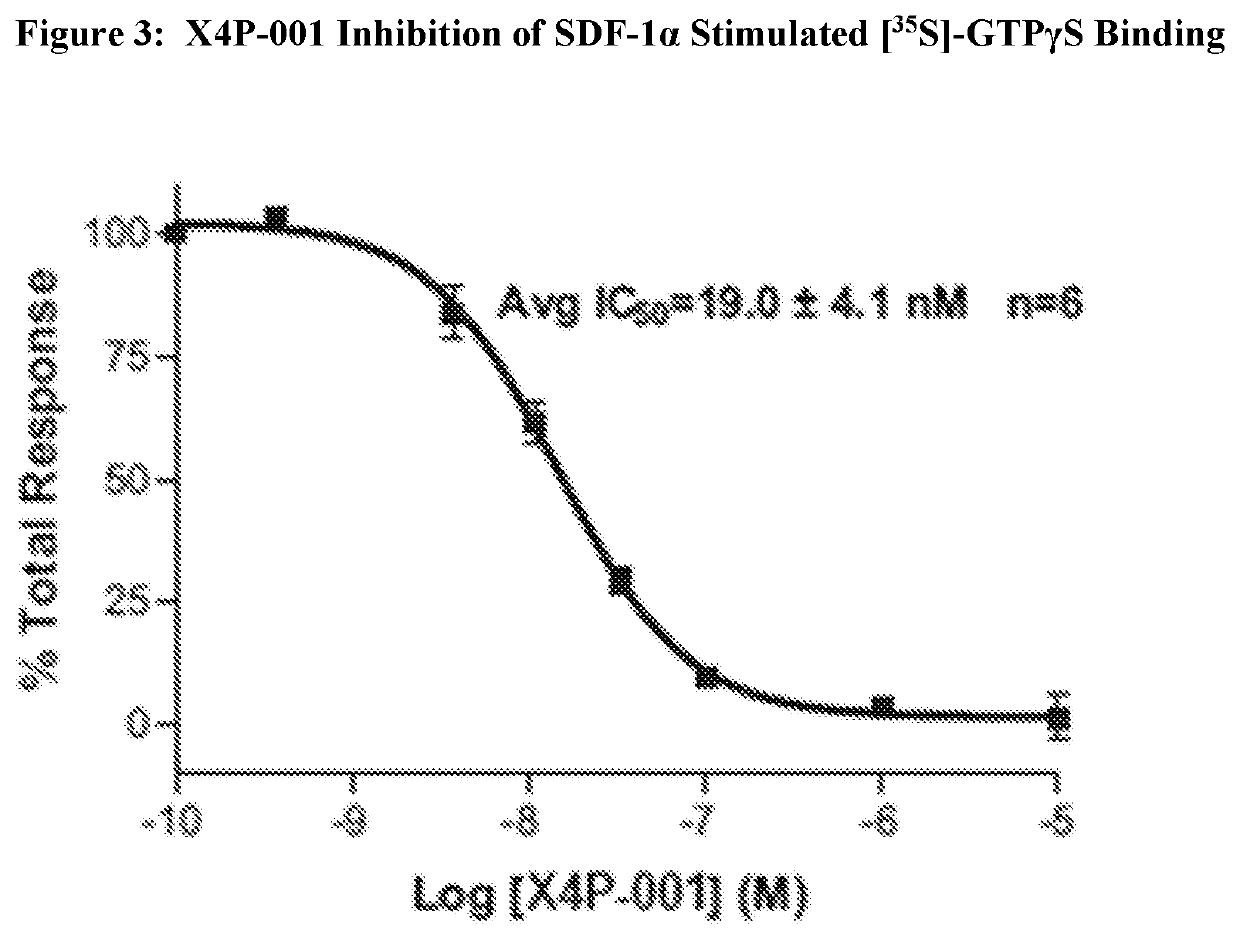Methods for treating immunodeficiency disease
a technology for immunodeficiency disease and immunoglobulin, applied in the field of immunodeficiency disease, can solve the problems of low immunoglobulin level, widespread warts affecting hands, feet, trunk, and hands, and the risk of cervical carcinoma is increased, and the risk of warts progressing to cervical carcinoma
- Summary
- Abstract
- Description
- Claims
- Application Information
AI Technical Summary
Benefits of technology
Problems solved by technology
Method used
Image
Examples
example 1
cal Evaluation of X4P-001 Effects on CXCR4
[0095]The in-vitro pharmacology of X4P-001 (formally designated AMD11070) was extensively studied and the results reported [Mosi 2012]. Presented below is the relevant information from the Mosi 2012 literature publication. The SDF-1α isoform was used for the experiments described below.
X4P-001 Inhibition of SDF-1α Binding to CXCR4
[0096]X4P-001 was shown to inhibit binding of [125I]-SDF-1α to CCRF-CEM cells (T-lymphoblastoid cell line which naturally express CXCR4 [Crump 1997]) in a heterologous competition binding assay. The results of the assay are shown in FIG. 2 below. The data was fitted to a single site binding model and gave an IC50 of 12.5±1.3 nM.
X4P-001 Inhibition of CXCR4 Cell Signaling
[0097]CXCR4 is a G-protein coupled receptor [Baggiolini 1998, Zlotnik 2000]. As such the activation of the receptor can be measured using a nonhydrolysable analogue of GTP such as fluorescently labeled Europium-GTP (Eu-GTP) or rad...
example 2
Patients to be Treated
[0144]Patients who may be treated according to the present invention include patients who have been diagnosed with WHIMS or with MKX; and patients who present the characteristic mutations in their CXCR4 gene. Other patients who may benefit from the present invention may include individuals presenting with the following screening criteria:
[0145]Neutropenia (ANC≤400 or ≤600 / μL) and / or lymphopenia (ALC ≤650 or ≤1000 / 4)—the latter is not characteristic of other chronic neutropenias;
[0146]Neutropenia and chronic warts;
[0147]Myelokathexis on bone marrow aspirate;
[0148]Patients meeting the above criteria are genetically screened for MKX. Patients with the characteristic mutations in CXCR4 are the most likely to benefit from treatment in accordance with the present invention.
[0149]Thus, the effects of X4P-001 is expected to be greatest in patients with myelokathexis associated with mutation in CXCR4. In addition, patients who may benefit from treatment according to the...
example 3
Treatment Regimens
[0167]Dosing Regimen for Patients with WHIM Syndrome:
[0168]X4P-001 at a determined dose of 25 mg or 50 mg daily is administered orally. Patients are instructed about both dosing schedule and requirements relating to food or drink near the time of dosing.
[0169]Dosing Schedule.
[0170]The first daily dose is taken in the morning. For twice daily dosing, doses should be taken twelve hours apart. Dosing should be at the same times each day ±2 hr.
[0171]Restrictions relating to food. Absorption is impacted by food and patients will be instructed as follows:
[0172]For the morning dose:[0173]No food or drink (except water) after midnight until the time of dosing[0174]No food or drink (except water) for 2 hour after dosing.
[0175]Dosing of X4P-001 may be adjusted by the clinician as appropriate. The dose of X4P-001 may be lowered according to the judgment of the clinician. If a patient receiving X4P-001 experiences an adverse event at Grade >2, the dose of X4P-001 may be lowere...
PUM
| Property | Measurement | Unit |
|---|---|---|
| pH | aaaaa | aaaaa |
| pH | aaaaa | aaaaa |
| time | aaaaa | aaaaa |
Abstract
Description
Claims
Application Information
 Login to View More
Login to View More - Generate Ideas
- Intellectual Property
- Life Sciences
- Materials
- Tech Scout
- Unparalleled Data Quality
- Higher Quality Content
- 60% Fewer Hallucinations
Browse by: Latest US Patents, China's latest patents, Technical Efficacy Thesaurus, Application Domain, Technology Topic, Popular Technical Reports.
© 2025 PatSnap. All rights reserved.Legal|Privacy policy|Modern Slavery Act Transparency Statement|Sitemap|About US| Contact US: help@patsnap.com



